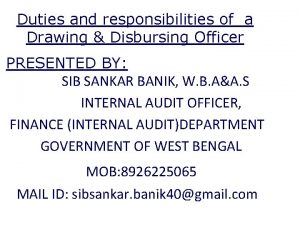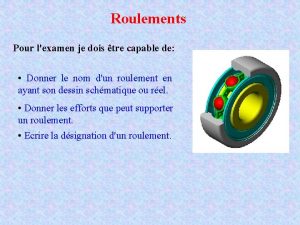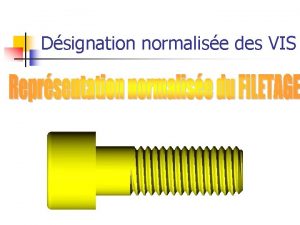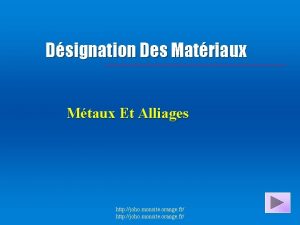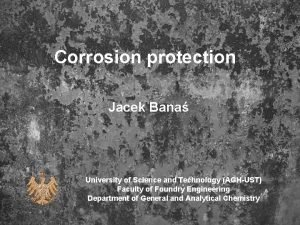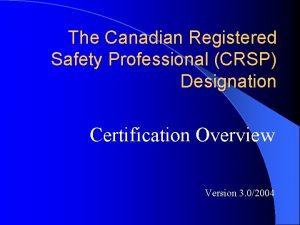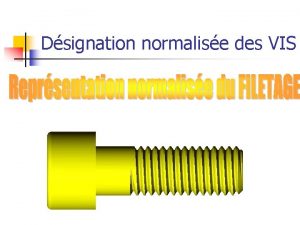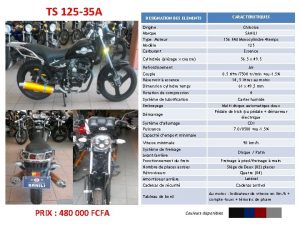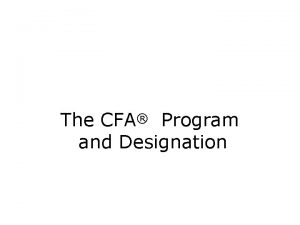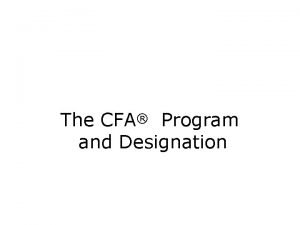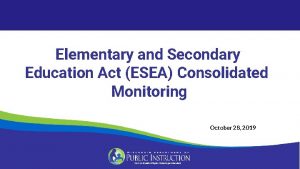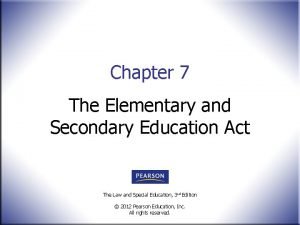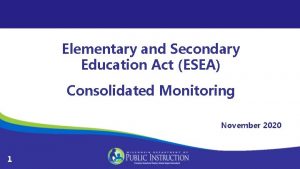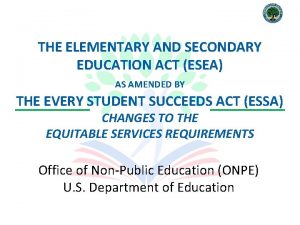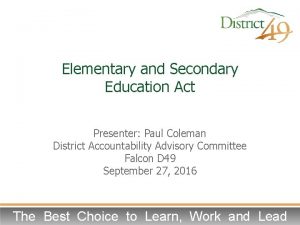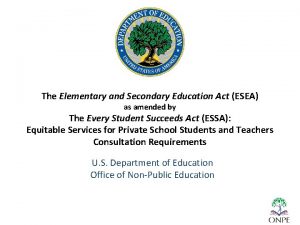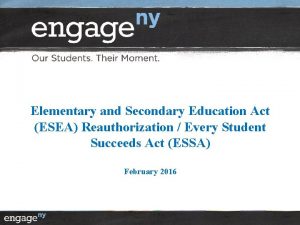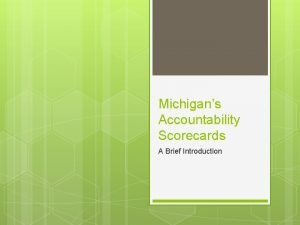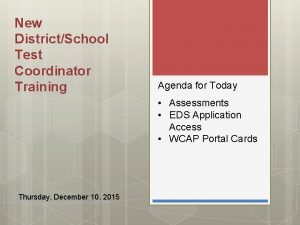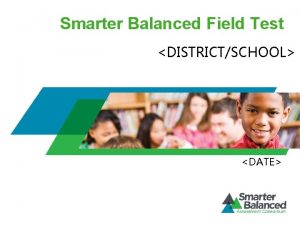ELEMENTARY AND SECONDARY EDUCATION ACT Focus DistrictSchool Designation


















- Slides: 18

ELEMENTARY AND SECONDARY EDUCATION ACT Focus District/School Designation Madison Oneida BOCES Office of labor Relations Andrew V. Lalonde, Labor Relations Coordinator March 28, 2016

NYS Elementary Secondary Education Act (ESEA) • On June 23, 2015, the US Dept. of Education approved New York’s ESEA Flexibility Waiver Renewal. • At the October 2015 Board of Regents meeting, the Board adopted permanent regulations to conform with the requirements of ESEA. • New York State of required by the ESEA Waiver to identify new Priority Schools, Focus Districts and Focus Schools.

How are Districts and Schools Identified? • New York State Education Department (SED) identifies low performing districts as “Focus Districts” and low performing schools within these districts as “Focus Schools. ”

New York Mills Union Free School District Designation • The N. Y. S. Education Department has designated the New York Mills Union Free School District as an underachieving “focus district. ” • The designation came as a result of the performance index value identified by the State for students with disabilities.

What are “Focus Districts” and “Focus Schools” Focus Districts have schools with low academic performance on Grades 3 -8 ELA and Math Tests or low graduation rates with certain groups of students, such as those who are economically challenged, disadvantaged, students with disabilities, and English Language learners. Focus Schools are schools within a Focus District that have low academic performances that are not improving.

SED Designations of “Focus” Schools with a 2014 -2015 performance that places them among the lowest performing in an “accountability subgroup” are designated by the State as a “Focus School. ” • “Focus School” designation is a result of one of the following: 1. One or more schools in the district being designate as a “priority school”. 2. One or more accountability groups in the district based on the 2014 -2015 school year data as being among the lowest performing in the state for English language arts (ELA) and mathematics Performance Index (PI) results combined. 3. One or more of the accountability groups in the district being preliminarily identified for the 2010 graduation-rate total cohort as of August 31, 2014 as among the lowest performing in the state.

What is a “Focus” School 4. The accountability group(s) for which the district has been preliminarily identified have not met any of the progress filters listed in the methodology documents. SEE: N. Y. S. Commissioner of Education Regulations Sections 100. 18 and 100. 19.

Criteria for the Identification of a Focus District and Focus Schools The Department of Education identified Focus Schools based on the following factors, as defined by ESEA: 1. Schools with the lowest achievement of subgroups in terms of proficiency on the statewide assessments that are part of the state’s differentiated recognition, accountability and support system and are not making progress as defined by New York’s progress filters. 2. High schools with the lowest Graduation Rate for subgroups that are not making progress as defined by New York’s progress filters.

Criteria for Identification of Focus Districts/Schools The Department identified Focus Schools using a two-stage process. Stage 1: NYSED first identified Focus Districts with the lowest achieving subgroups for Performance Index (PI) and Graduation Rate that were not making progress. Stage 2: NYSED then identified the lowest performing Title 1 schools statewide within the identified Focus Districts. Non-Title 1 schools within the Focus Districts that met the Focus District cut points were also identified as Focus Schools. • Districts are identified as Focus Districts if any subgroup is identified either through the PI or Graduation Rate methodology.

What are “Progress Filters? ” • Progress filters are alternate measures used to determine whether districts and schools have made sufficient educational growth and progress. • Some of the key progress filters are: 1. Group has made a ten (10) point gain in the Performance Index from the prior school year. 2. Median Student Growth Percentile is above Statewide average. 3. Subgroup’s 4 and 5 -year graduation rate is above Statewide average or has increased by ten percent (10%) over the last two years.

What Do Districts and/or Schools Have to Do? • Focus Districts and Focus Schools will undergo a school improvement process to help address the reasons why some students in the schools are not succeeding. • These districts and schools will participate in a State review process to identify the strengths and weaknesses of the district or school. • Districts and schools will use the information derived from these reviews to develop improvement plans.

District Effectiveness Reviews and Requirements • Commissioner’s Regulations 100. 18 require that all Focus Schools participate in a diagnostic review of quality indicators. • The reviews are expected to inform subsequent: 1. 2. School Comprehensive Education Plans (SCEPs); and District Comprehensive Improvement Plans (DCIPs).

School and District Effectiveness Review (DTSDE) This review evaluates school and district performance in 6 tenets: 1. district leadership and capacity; 2. school leadership practices and decisions; 3. curriculum development and support; 4. teacher practices and decisions; 5. student social and emotional development health; and 6. family and community engagement.

School and District Effectiveness Review (cont. ) • All Focus Schools are required to receive a DTSDE review in the 2015 -2016 school year. • Focus districts with no focus school(s) will be expected to complete an annual, District Comprehensive Improvement Plan (DCIP).

What are the DTSDE Review Requirements? This requirement can be fulfilled in one of three ways: 1. A NYSED-led IIT review; 2. A DTSDE review of three or more tenets led by an Outside Educational Expert with a District Lead Credential; or 3. A District-Supervised completed DTSDE School Self-Reflection.

District Comprehensive Improvement Plan Requirements • Focus Districts are required to develop a District Comprehensive Improvement Plan. • The purpose of this plan is to articulate how the district will use the full range of its resources to support improvements. • Focus Districts must utilize the Diagnostic Tool for School and District Effectiveness (DTSDE) and the DTSDE school visit review process as tools for improvement through the DCIP.

Requirements for the DCIP and SCEP • The DCIP and SCEP must specifically address the areas of need identified through the use of the diagnostic tool quality indicators. • They must be updated annually as approved by the Board of Education and implemented no later than the first day of school when students are in attendance. • Be developed in consultation with parents, school staff, and others pursuant to Commissioner’s Regulations Section 100. 11. • Include an analysis of achievement of prior year goals. • Be made widely available through public means. • Are due to SED by Friday, July 31, 2016.

QUESTIONS
 Integrated cost leadership/differentiation strategy
Integrated cost leadership/differentiation strategy Cost focus and differentiation focus
Cost focus and differentiation focus Prolepsis
Prolepsis Actor focus vs object focus
Actor focus vs object focus Disbursement officer duties and responsibilities
Disbursement officer duties and responsibilities Macbeth summary
Macbeth summary What is the conflict in the crucible act 2
What is the conflict in the crucible act 2 Désignation roulement à bille
Désignation roulement à bille Exercice désignation des vis
Exercice désignation des vis 25 cr mo 4 désignation
25 cr mo 4 désignation Trou taraudé débouchant
Trou taraudé débouchant Galvanic element
Galvanic element Smaw electrode designation
Smaw electrode designation Certified in exhibition management
Certified in exhibition management What is crsp certification?
What is crsp certification? Professor designation
Professor designation Désignation normalisée vis
Désignation normalisée vis 888-663-8081
888-663-8081 125+35
125+35




